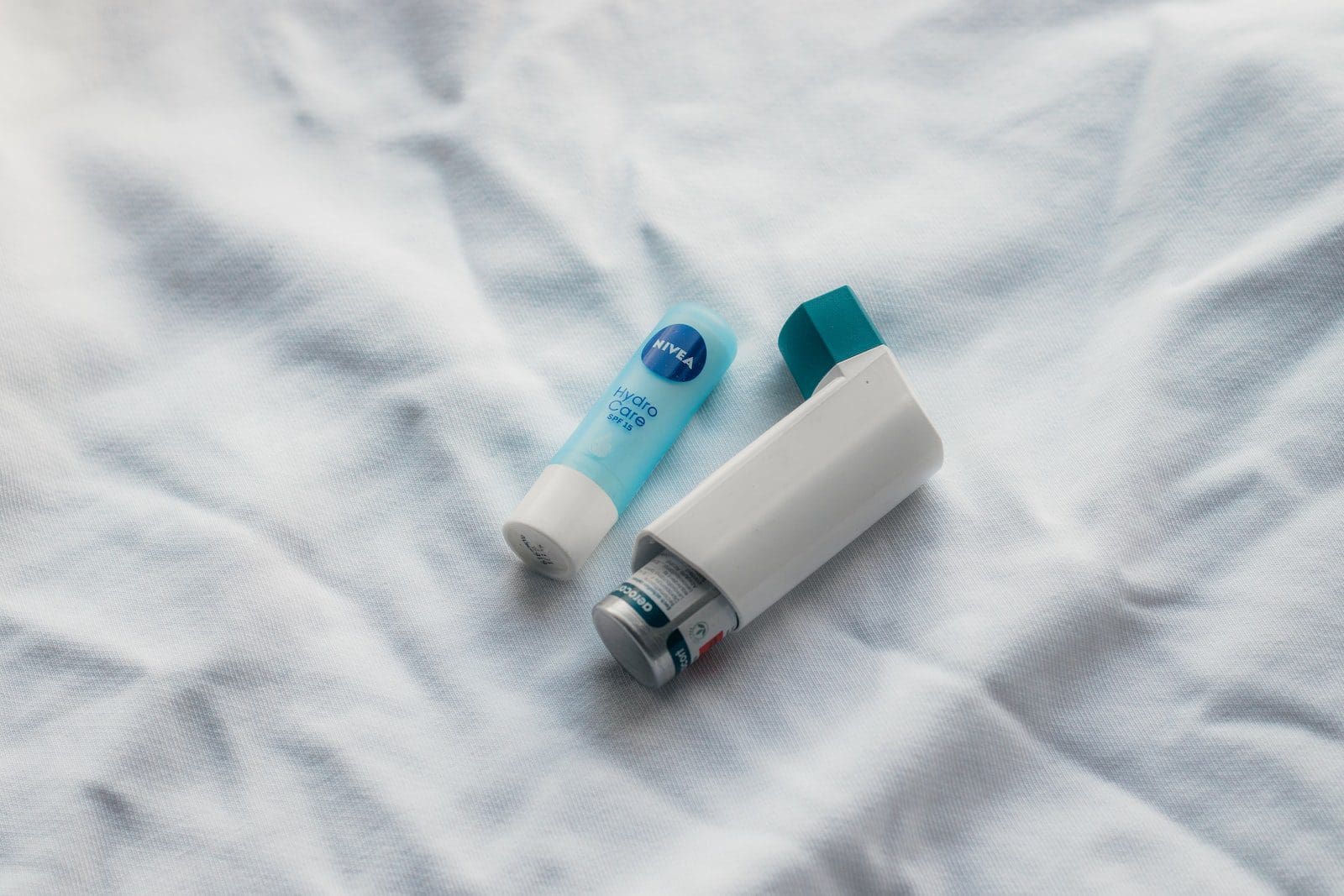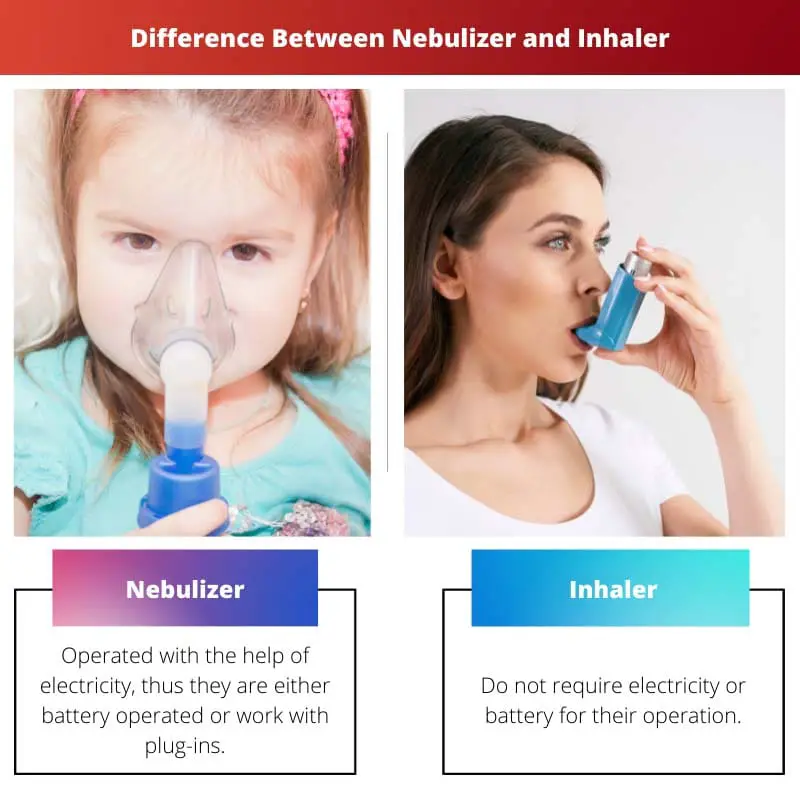Inhalation therapy is commonly used to treat respiratory illnesses such as COPD, cystic fibrosis and asthma. The instruments which are used to dispense these drugs can be preventers or relievers, including inhalers and nebulizers.
Key Takeaways
- A nebulizer is a device that converts liquid medication into a mist that can be inhaled into the lungs.
- An inhaler is a device that delivers medication in the form of a spray or aerosol directly into the lungs.
- Nebulizers are used for people with respiratory problems, such as young or older adults, with difficulty using inhalers.
Nebulizer vs Inhaler
Nebulizer is a small machine that can turn liquid medicine into a mist so that the patient can inhale it. It is commonly used to treat asthma, COPD, cystic fibrosis, and other respiratory diseases. Inhaler is a medical device that is used for delivering medicine into the lungs to help with breathing.

Compressors, such as nebulizers, are used to deliver oxygen or any other compressed air. With the use of a tube, the confined air can be given to your mouth. Nebulizers rely on electricity to function.
Inhalers are metal or plastic devices that carry a pressurised medication solution inside a tin canister. When the user presses the canister, the medication is dispensed in predetermined amounts into the mouth.
Comparison Table
| Parameters of Comparison | Nebulizer | Inhaler |
|---|---|---|
| Size and Appearance | Bulkier in size and appearance. | Small in size and can be held in hands. |
| Operated via? | Operated with the help of electricity, thus they are either battery operated or work with plug-ins. | Do not require electricity or battery for their operation. |
| Cost | Expensive and higher cost. | Cheaper and cost-effective. |
| Portability | Not portable or travel friendly. | Portable, pocket and travel are friendly. |
| Side effects | Tremors, anxiety, severe breathing issues. | Poor breathing problems. |
| Use | Severe difficulty in breathing issues, tracheostomy collar. | Minor breathing problems or asthma. |
What is Nebulizer?
A nebulizer is a device that is larger in appearance. Compressors, such as nebulizers, are used to deliver oxygen or other compressed air. With the use of a tube, confined air can be given to the mouth.
Nebulizers are electronic devices that are specifically designed to treat respiratory disorders. As a result, they are more expensive than inhalers. Ambulizers and hospitals both have nebulizers.
Because asthma treatments are delivered via nebulizer, nebulizers can induce side effects in patients, such as tremors and anxiety, if they are not utilised properly.

What is Inhaler?
Inhalers are compact and can be carried in one’s hand. Inhalers are devices that contain the medicine solution in a pressurised form inside a tin canister.
Inhalers are little plastic devices that operate without the use of power or batteries. Inhalers are less expensive and more cost-effective. As a result, they’re useful for folks who have respiratory problems.
When an inhaler is not utilised correctly in conjunction with breathing, it might result in poor breathing problems for asthma patients—people who suffer from minor respiratory issues or asthma use inhalers daily.

Main Differences Between Nebulizer and Inhaler
- If not used correctly, then nebulizers can cause side effects in patients like tremors and anxiety due to the delivery of asthma medicines via nebulizer. On the other hand, If an inhaler is not used correctly in coordination with breathing, then it can cause poor breathing problems for individuals suffering from asthma.
- Nebulizers are used extensively for administering patients who face severe difficulty in breathing or who have tracheostomy collars in hospitals and ambulances. On the other hand, inhalers are used in day-to-day lives by people suffering from minor breathing problems or asthma.

- https://www.atsjournals.org/doi/abs/10.1164/ajrccm.163.1.9910042
- https://www.sciencedirect.com/science/article/pii/0091674981900129

The detailed explanations and vivid descriptions in the article have significantly enriched my understanding of nebulizers and inhalers.
The comparison is quite insightful, providing clarity on the use of nebulizers and inhalers.
I am impressed by the level of detail provided.
The article provides an in-depth comparison between nebulizers and inhalers including their effectiveness and side effects.
I found it really useful.
I agree, it is quite informative.
The comparison table and detailed descriptions have significantly improved my knowledge of nebulizers and inhalers.
This article is an invaluable resource for understanding the use of these devices.
They have provided an excellent comparison between nebulizers and inhalers.
The article has highlighted the key differences between nebulizers and inhalers, making it easier to understand how each works.
It is indeed very informative!
The comprehensive comparison provided in the article is quite helpful to understand the use and necessity of nebulizers and inhalers.
Yes, I have learned a lot from the article.
The detailed explanation about the size, operation, and side effects of nebulizers and inhalers is enlightening.
I think this information can be valuable for both patients and healthcare professionals.
Agreed, it’s very educational.
The article has effectively highlighted the differences in use, side effects, and portability between nebulizers and inhalers.
It has certainly broadened my understanding about nebulizers and inhalers.
The article effectively illustrates the use and benefits of nebulizers and inhalers, allowing for a better understanding of their efficiency.
I am impressed by the clarity and depth of information provided.
The article is thorough and well-explained, offering a clear understanding of the roles and differences between nebulizers and inhalers.
The analysis and discussion provided in the article are commendable.
It is an informational goldmine for anyone interested in the topic.
The article is a valuable source of information for anyone seeking to understand the differences between nebulizers and inhalers.
It has provided a deep insight into the working and implications of nebulizers and inhalers.